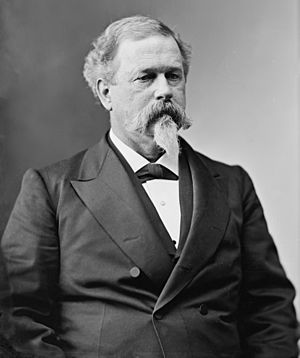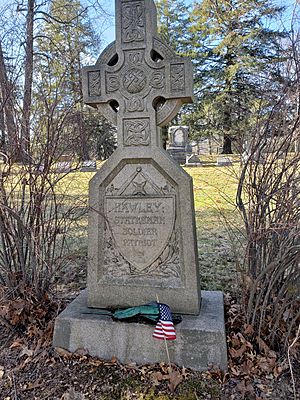Joseph Roswell Hawley facts for kids
Quick facts for kids
Joseph Roswell Hawley
|
|
|---|---|
 |
|
| United States Senator from Connecticut |
|
| In office March 4, 1881 – March 3, 1905 |
|
| Preceded by | William W. Eaton |
| Succeeded by | Morgan G. Bulkeley |
| 42nd Governor of Connecticut | |
| In office May 2, 1866 – May 1, 1867 |
|
| Lieutenant | Oliver Winchester |
| Preceded by | William A. Buckingham |
| Succeeded by | James E. English |
| Member of the U.S. House of Representatives from Connecticut's 1st district |
|
| In office December 2, 1872 – March 3, 1875 |
|
| Preceded by | Julius L. Strong |
| Succeeded by | George M. Landers |
| In office March 4, 1879 – March 3, 1881 |
|
| Preceded by | George M. Landers |
| Succeeded by | John R. Buck |
| Personal details | |
| Born | October 31, 1826 Stewartsville, North Carolina |
| Died | March 18, 1905 (aged 78) Washington, D.C. |
| Political party | Republican |
| Alma mater | Hamilton College |
| Signature |  |
| Military service | |
| Allegiance | Union |
| Branch/service | United States Army Union Army |
| Rank | |
| Battles/wars | American Civil War |
Joseph Roswell Hawley (October 31, 1826 – March 18, 1905) was an important American figure. He served as the 42nd Governor of Connecticut. He was also a U.S. politician, a general during the American Civil War, and a journalist. Hawley was a member of the Republican and Free Soil parties. He spent two terms in the United States House of Representatives and four terms as a U.S. Senator.
Contents
Early Life and Political Start
Joseph Hawley was born in Stewartsville, North Carolina. His father was a Baptist pastor from Connecticut. In 1837, his family moved back to Connecticut. Joseph went to Hamilton College in New York and graduated in 1847. He became a lawyer in 1850 and worked in Hartford, Connecticut for six years.
Hawley strongly opposed slavery. He joined the Free Soil Party, which was against slavery spreading into new territories. He became the editor of the party's newspaper, the Charter Oak. In 1856, he helped create the Republican Party in Connecticut. The next year, he became the editor of the Hartford Evening Press, a new Republican newspaper.
Serving in the Civil War
Hawley served bravely in the Union army during the American Civil War. He started as a captain and rose to the rank of major general. In April 1861, he helped gather soldiers for the 1st Connecticut Infantry. He fought in his first battle at First Battle of Bull Run in July. His commander, General Erasmus D. Keyes, praised his actions.
After his first service, Hawley helped raise the 7th Connecticut Infantry. He became its lieutenant colonel. He took part in the Battle of Port Royal in November 1861. He also helped capture Fort Pulaski in April 1862. Later, he commanded the 10th Connecticut regiment.
In 1863, Hawley led troops in Florida. He also participated in an attempt to capture Charleston, South Carolina. During the siege of Charleston, he commanded a brigade on Morris Island. He helped attack Fort Wagner in September. His regiment was one of the first to use new, faster-firing rifles.
In 1864, Hawley commanded a brigade in the Battle of Olustee in Florida. Later, his troops moved to Virginia. He fought in battles near Bermuda Hundred and Deep Bottom. He commanded a division during the Siege of Petersburg. In September 1864, he was promoted to brigadier general. He also led a special brigade to New York City to keep peace during the November elections.
In January 1865, Hawley became a division commander. He later became Chief of Staff for the X Corps in North Carolina. After Wilmington was captured, Hawley commanded the forces in southeastern North Carolina. He was promoted to major general in September 1865. He left the army in January 1866.
Life After the War
After the war, Hawley became the governor of Connecticut in April 1866. He served for one year. Later, he bought the Hartford Courant newspaper and combined it with his old paper. This newspaper became very important in Connecticut.
Hawley was a key figure in the Republican Party. He led the Republican National Convention in 1868. He also attended other conventions. He served in the United States House of Representatives from 1872 to 1875 and again from 1879 to 1881.
From 1873 to 1876, Hawley was president of the United States Centennial Commission. This group planned the Centennial Exhibition in Philadelphia. This big event celebrated 100 years of American independence. He also received honorary degrees from Hamilton College and Yale.
Hawley became a United States Senator in 1881 and served until 1905. He was a major Republican leader in both the House and the Senate. He worked to improve the civil service, which is about how government jobs are filled. He also led a committee that looked into how military weapons and warships were made.
Joseph Hawley passed away in Washington, D.C., on March 18, 1905. He was the longest-serving Senator from Connecticut at that time. A special bronze artwork of Hawley was placed in the Connecticut State Capitol building in 1912. He is buried in Cedar Hill Cemetery in Connecticut. A military battery at Fort Baldwin in Phippsburg, Maine is named in his honor.
Personal Life
Joseph Hawley and his wife, Harriet Foote Hawley, adopted one of Harriet's nieces. This niece, Margaret Foote Hawley, later became a well-known painter of small portraits. Harriet's sister, Kate Foote Coe, also lived with the Hawleys while working as a newspaper writer in Washington.
Images for kids



